
If you notice a rising trend in clients missing their appointments at your salon, it’s time to implement a salon cancellation policy. Our guide will show you how to write one and what you can do to increase its effectiveness.
Ideally, all the appointments booked at your salon will take place as scheduled. But as an experienced salon worker, you know that things don’t always go as planned.
Most beauticians are happy to reschedule appointments if a client informs them early enough that they can’t make it.
The predicament becomes more difficult to handle when a client waits too long before notifying the salon.
To navigate late cancellations more easily, implement a salon cancellation policy.
That way, your clients get a clear overview of the terms and conditions for cancelling, and you get to protect your salon from losing income.
For this guide, we’ve gathered the best cancellation policy examples from the industry.
When you see how other salons handle cancellation timeframes and fees, you’ll be able to determine what kind of policy fits your salon the most.
So let’s get down to it.
Displaying your cancellation policy does more than reduce no-shows; it demonstrates the work ethic of your salon.
Such policies are usually constructed as the first step in combating late cancellations and no-shows. But there are additional messages your cancellation policy sends.
If you set the policy in a visible place in your salon, you signal to your clients that you are a professional as soon as they enter the place.
Let’s see how.
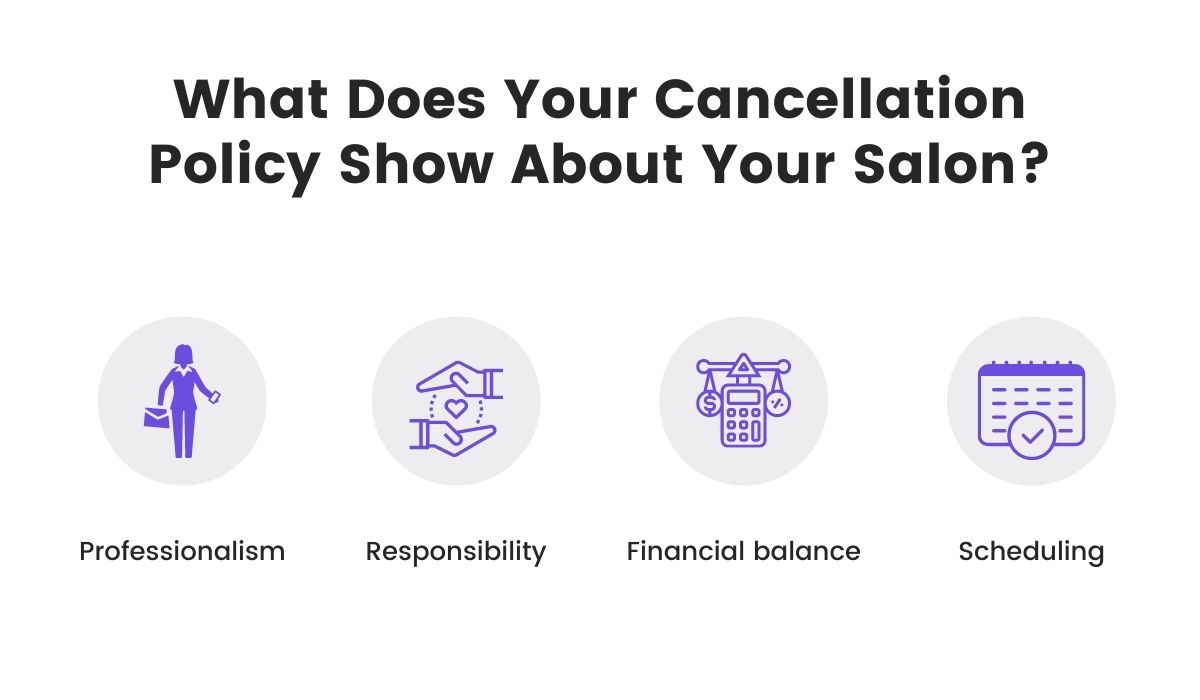
Source: Zoyya
Doing your friends’ nails as a hobby is one thing; running a salon is a whole other level. Having a cancellation policy shows that you are a professional who sets value on your work and takes the business seriously.
Keep in mind that cancellations are the starting point of a vicious circle.
If a client is late or doesn’t show up, your next scheduled appointment will also start late, triggering a chain reaction.
Missed appointments cause missed earnings, eventually forcing you to cut corners and perhaps even switch to some less than ideal practices to remain financially balanced, such as using lower-quality products.
However, if you establish a firm policy on appointment cancellations, it will be easier to maintain high standards in your salon.
As much as you love what you do, you’re still running a business.
You have a financial plan to stick to, so you need compensation for the time lost when clients don’t show up. Don’t be afraid to put a value on your time.
Last but not least, a cancellation policy shows that good time management is a priority in your salon. Combined with a great booking app, your cancellation policy can go a long way to ensure your clients are served without delay.
That’s important for maintaining customer satisfaction. A TimeTrade survey has revealed that 75% of businesses report losing customers due to wait-related issues.
So, if you want satisfied clients, don’t let them wait.
Now that we’ve seen how a cancellation policy can elevate your salon image, let’s see how to create one.
Some salons use a 24-hour cancellation policy, while some opt for the tiered policy. We’ll show you examples of both so that you can find the most effective type for your salon.
The 24-hour cancellation policy owes its popularity to its simplicity. The only rule the clients have to obey is to give the salon a heads up at least a day before the appointment they can’t come to.
By implementing a 24-hour policy, you agree not to charge a fee when clients let you know they won’t be able to come to the appointment at least a day before it’s scheduled. Clients only have to pay a fee if they fail to give a 24-hour notice.
Here’s how it can look in practice.
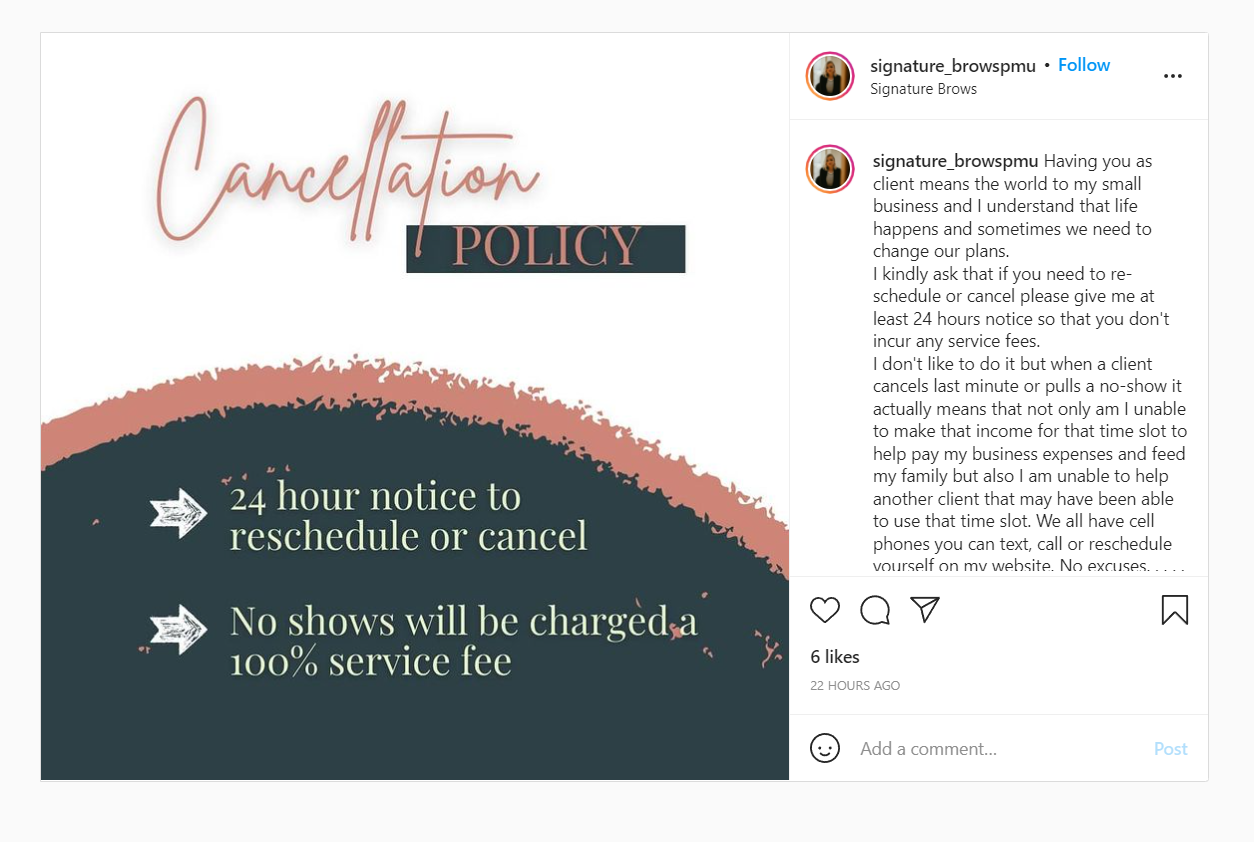
Source: Instagram
On the other hand, the tiered cancellation policy is a bit more complex, but it offers you more options for collecting cancellation fees.
Where the 24-hour policy has a fixed requirement, a tiered policy implies different fees depending on when a client cancels the appointment.
Let’s take a look at an example from a lash and brow salon.
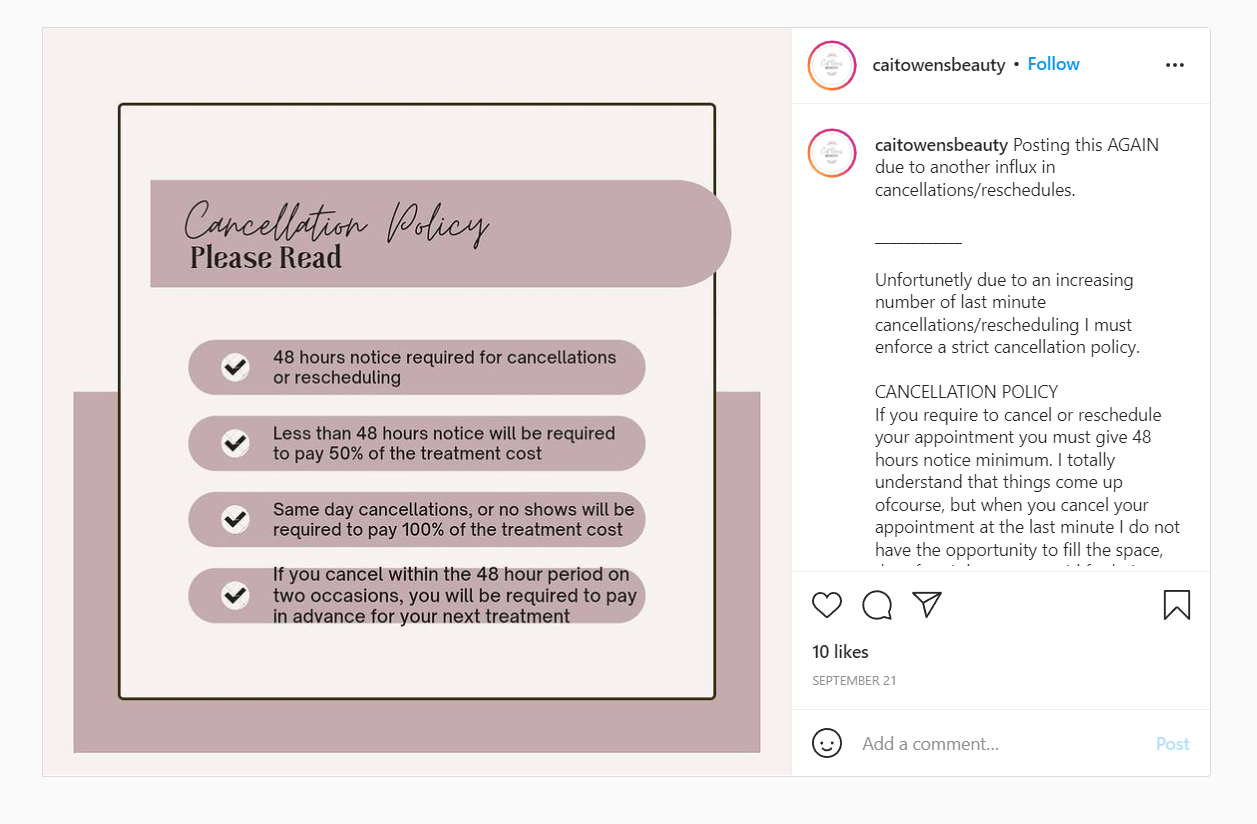
Source: Instagram
This salon states that clients who give notice of fewer than 48 hours have to pay 50% of the treatment cost. Those who give a shorter notice pay a higher fee, i.e., 100% of the cost.
Finally, repeat offenders are required to pay a deposit for the next treatments.
Even though the cancellation policy of this salon has three compensation tiers, note how clearly it was worded. The salon owner did her best to keep the terms and conditions simple and understandable.
You can choose between a 24-hour policy and a tiered one based on the type of services you provide.
For the salons that mostly do quick services and accept walk-ins, a 24-hour policy may be enough.
However, if you usually do treatments that are on a longer side or have your services booked weeks in advance, your schedule may benefit from a tiered policy.
To make sure your cancellation policy is effective, you should clearly state when and how clients can cancel their appointments.
A standard cancellation policy formula includes all the information the clients need to know to cancel an appointment.
These are:
Your policy can include additional information, but these three elements are essential.
If you look at other salons’ cancellation policies, you’ll notice that they sometimes omit contact info. This usually happens when a salon posts their policy on Facebook or Instagram, because it’s implied that you can contact them there.
The following picture shows a cancellation policy written by a salon owner who included her Facebook page as a contact method. The phone number isn’t included in the policy, but the clients can find it with one click.
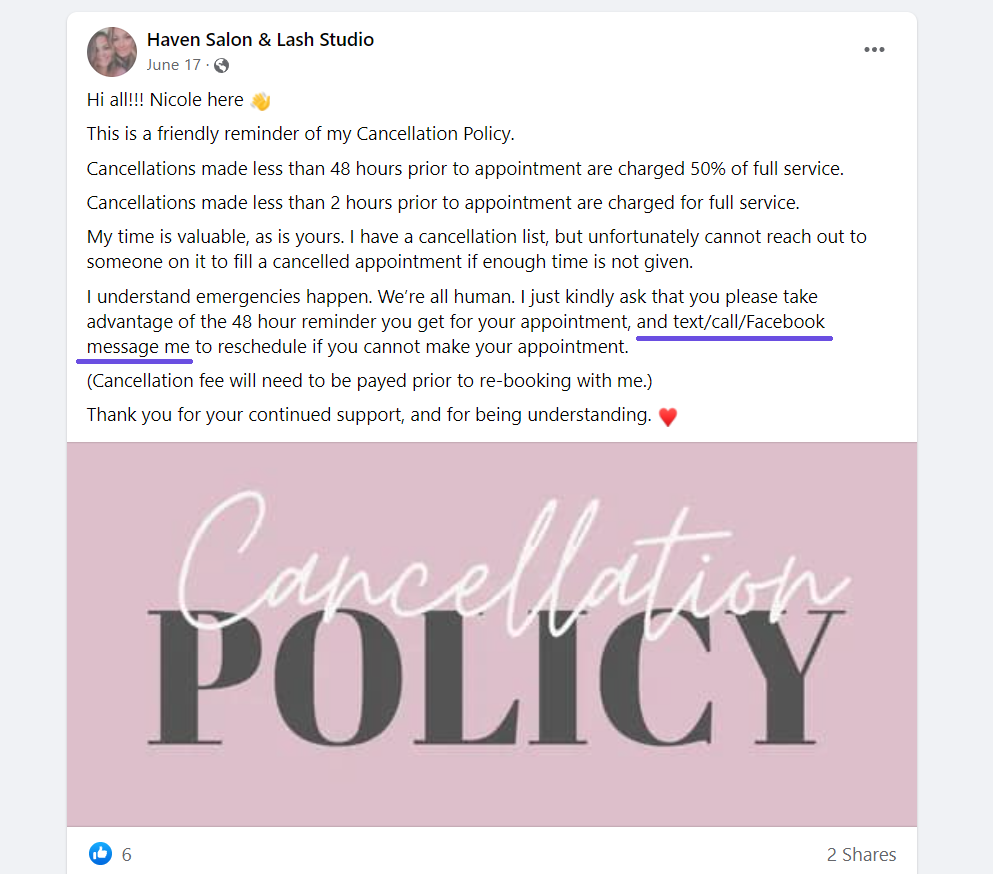
Source: Facebook
However, if you prefer phone calls or text messages straight to your phone, it’s helpful to list your phone number.
Similarly, if you want to avoid being inundated with phone calls, the easiest way to manage cancellations is directly through the treatment booking app you use.
In addition to instructions on how clients can cancel their appointments, your policy can also contain information on what happens if people misuse cancellations.
For instance, this skin-care salon reminded their clients that three cancellations or no-shows result in a $25 fee for future appointments.
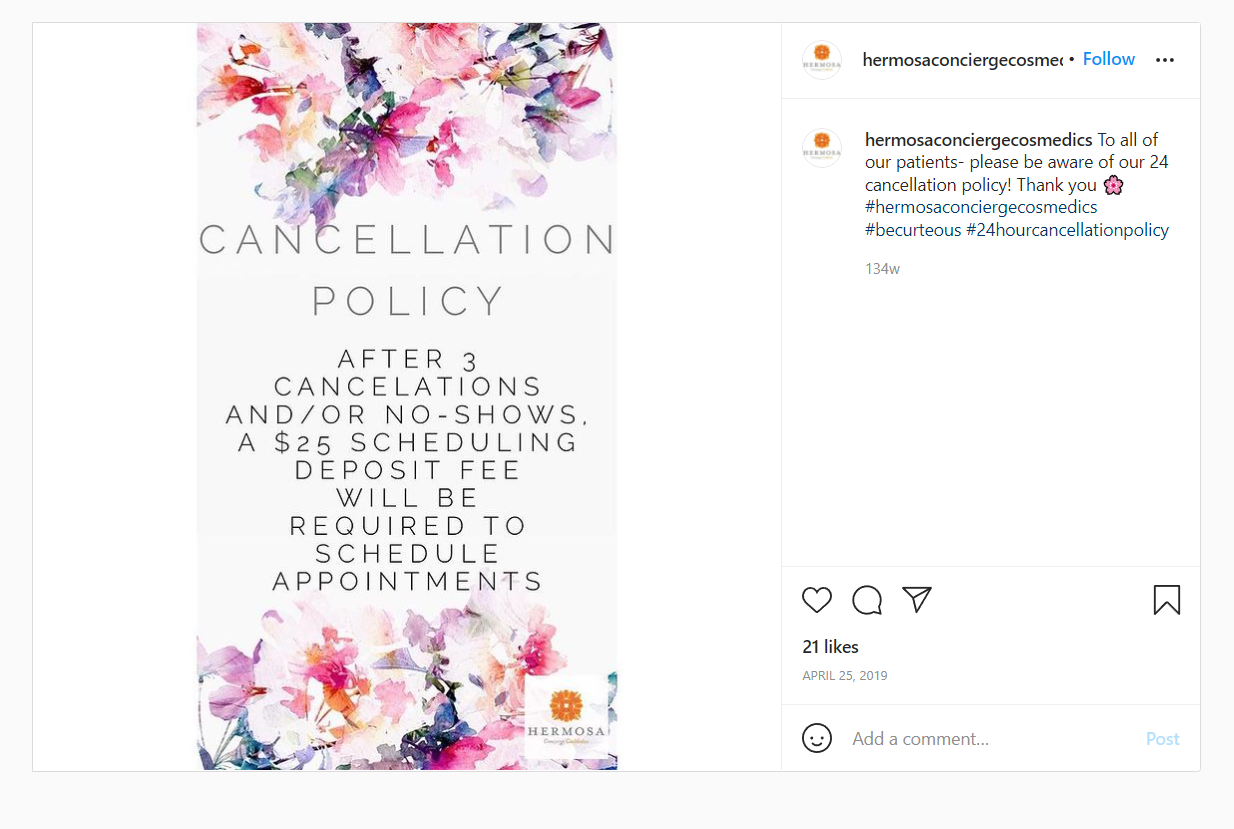
Source: Instagram
Whatever info you include in your cancellation policy, make sure to use clear and understandable language.
The language should also be direct in order to make it clear that your policy isn’t optional; it contains rules that are enforced in your salon.
If you’d rather invest your efforts in running your salon than in drafting custom policies, we’ve got your back.
You can find five free cancellation policy templates here. Some are simple and straightforward, while others are more extensive; so choose a template that you think resonates well with your clients.
Cancellation fees are a useful tool for protecting your bottom line. Charging such fees may be common practice, but before you go for it, make sure you comply with the local rules and regulations.
You can tackle the question of whether to charge cancellation fees from two perspectives: moral and legal.
Morally, there’s nothing wrong with cancellation fees as long as you’re transparent about them.
Inform your clients about the fees and charge exactly the way your policy says you would, with no fee increases.
Lilliane Caron, the owner of the waxing salon Smooth & Tan, says it’s time to stop fearing cancellation fees. Here’s how she sees the role of the cancellation policy and fees:
“The policy has two main goals. One: deterring people from making last-minute changes and two: covering wages and other costs if it does happen. It should be clear that it’s not a tool to make money.”
So, if you’re feeling uncomfortable about charging cancellation fees, remember to communicate their purpose, and your clients will understand.
Here’s how this salon described the aims of their policy to their clients:
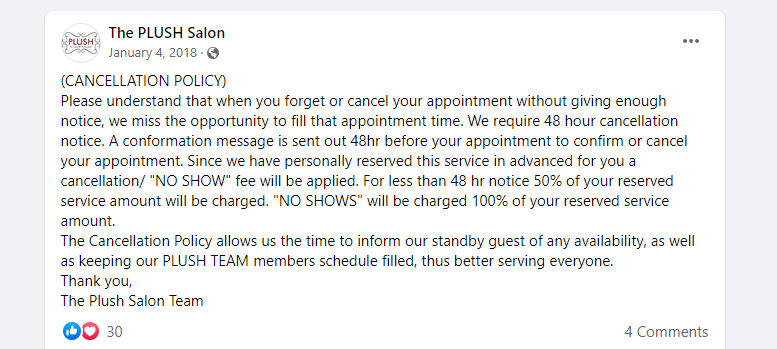
Source: Facebook
When you explain the reasoning behind your fee charging policy, you make it easier for clients to understand the importance of canceling on time.
Once again, client communication proves to be essential for your business.
Still, there are some legal boundaries when it comes to cancellation fees. Legally, you have to base your policy on more than your gut feeling.
Unfortunately, there’s no clear-cut answer to the legality of cancellation fees; it largely depends on your location.
For example, UK salons aren’t allowed to impose unfair penalties on clients who don’t show up for beauty appointments, but many salons still charge a full price for no-shows.
To make sure you’re operating legally, check your local laws and regulations so you can form an appropriate cancellation policy. If you still have some uncertainties, it would be best to seek legal advice from a professional.
The most effective cancellation policy is the one that’s used the least. This means that you’ve made it clear to your clients why last-minute cancellations are an issue, and have motivated your clients to avoid them.
Let’s recap the rules for creating a good salon cancellation policy:
You now have a foolproof formula for a cancellation policy, but there are more steps you can take to maximize its effectiveness.
For instance, even the clearest policy will remain futile unless you promote it publicly.
You can do this on the social networks you use, as shown throughout this article.
But if your salon also has a website, make sure to post your cancellation policy there as well.
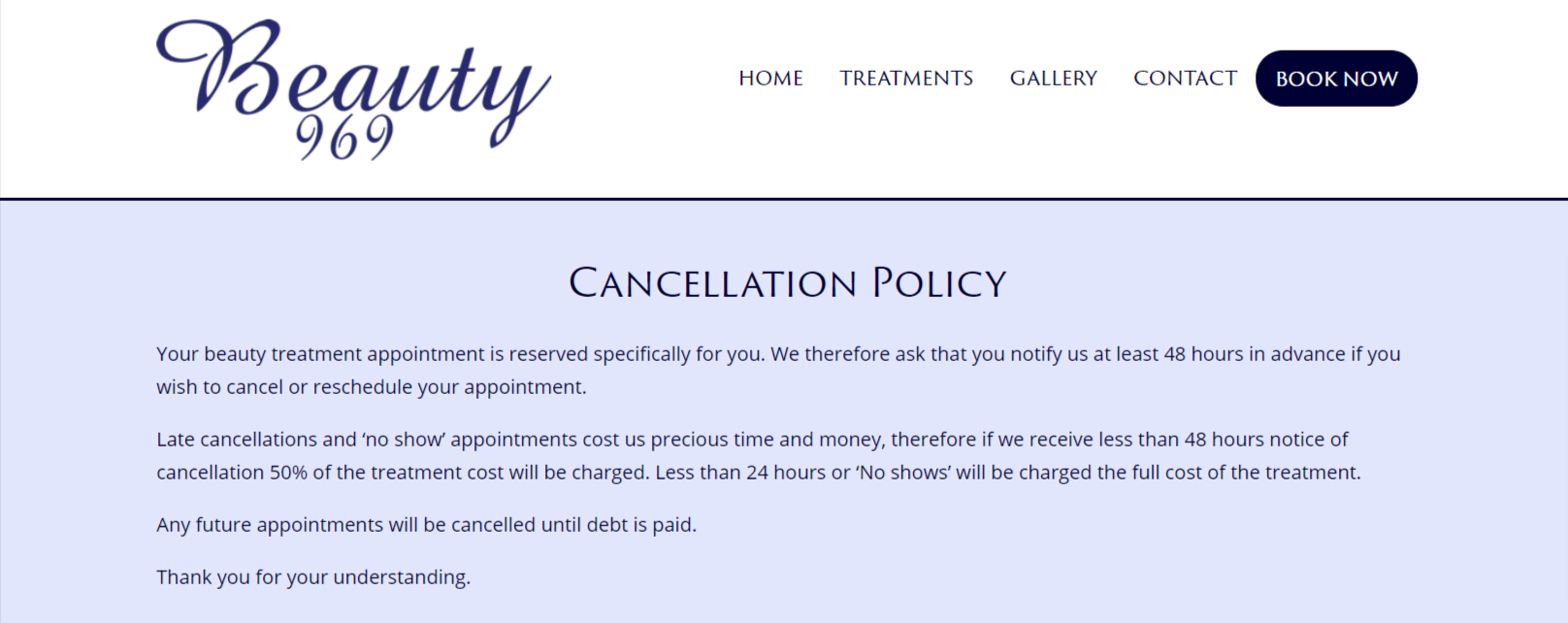
Source: Beauty 969
Don’t forget to display the cancellation policy in a visible place inside your salon, either.
Finally, instruct your staff to always tell the new clients about the policy so there are no surprises about fees should they ever cancel their appointment late.
But as we said, the best cancellation policies are left unused.
When your clients know they have an upcoming appointment with you, it’s more likely they will arrive as scheduled.
You can decrease the chances of clients forgetting their appointments by sending SMS reminders a few days before.
Luckily, you don’t have to spend hours hunched over your phone texting or emailing. We can help you send automatic SMS reminders with our booking app, Zoyya.
The Zoyya app lets your clients book appointments, and it automatically texts them a reminder a day or two in advance, depending on the settings you select.
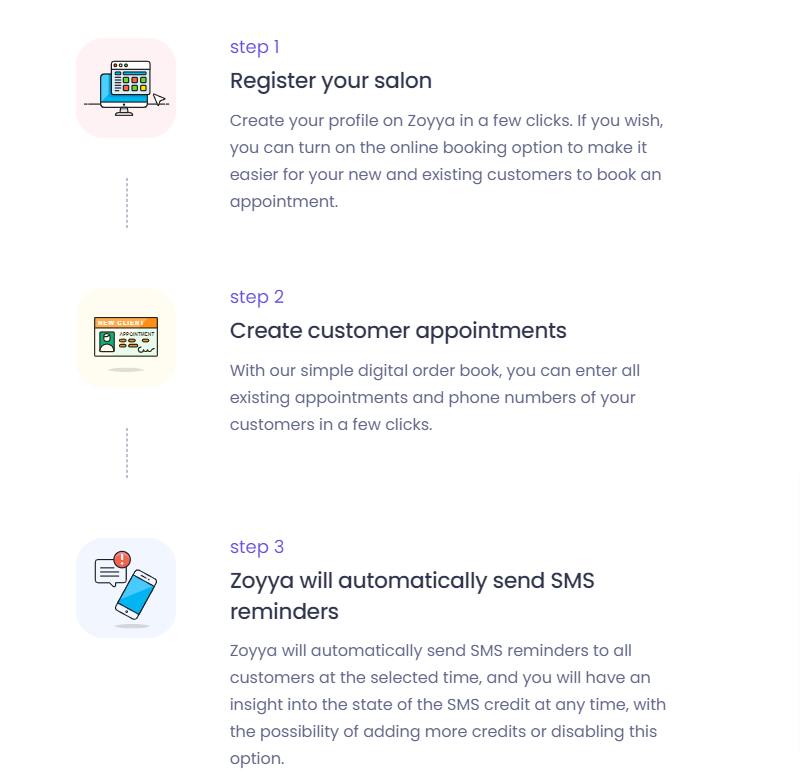
Source: Zoyya
The clients who have been using our booking system have reported 25% fewer missed appointments.
With a reminder system, you could use the cancellation policy as a fallback. It’s worth having it in place, but you’ll see that you’d have to utilize it way less frequently.
Even though you can significantly reduce no-shows with SMS reminders, it’s still helpful to have a cancellation policy in place.
The policy should inform clients of how and when they can cancel their appointments, and if any fees apply.
When you write the policy, don’t forget to inform your clients about it.
We hope this post gave you some insight into cancellation management. And if you want to reduce cancellations even further, you should give our automatic reminders a go.
We never send spam or share your email address.
We use cookies to enhance your browsing experience, serve personalized ads or content, and analyze our traffic. By clicking "Accept", you consent to our use of cookies.Read our cookie policy